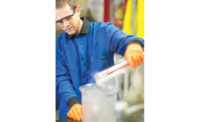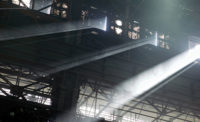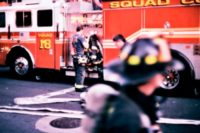Combustible dust is an ever-present hazard in many manufacturing facilities. The need and requirements to conduct a Dust Hazard Analysis (DHA) has increased over the last several years, partially due to the insurance carriers, permitting agencies, and corporate offices requiring facilities and companies to follow governing standards, and to protect employees and property from the potential of explosions and fires.
Background
In the National Fire Protection Association (NFPA) consensus standard NFPA 652 – Standard on the Fundamentals of Combustible Dust, combustible dust is defined as a finely divided combustible particulate solid that presents a flash-fire hazard or explosion hazard when suspended in air or the process-specific oxidizing medium over a range of concentrations.
Standards and regulations have been set up by agencies such as the NFPA, Occupational Safety and Health Administration (OSHA), and the Chemical Safety Board (CSB) to ensure that employee awareness, hazard identification, and mitigation of combustible dust hazards are properly in place. Since then local fire marshals, insurance carriers, and internal corporate risk departments have begun requiring facilities to identify and mitigate combustible dust and flammable material hazards according to overarching regulations and standards.
The NFPA sets the standards on the requirements for conducting DHAs, sizing of dust collection systems, specifications for mechanical and pneumatic conveyance systems, etc. OSHA is enforcing these codes and standards and issuing violations and citations when facilities fail to meet the specified requirements. There are several standards written to prevent dust fires and explosions, including “commodity specific” standards (e.g. NFPA 61, 484, 655, and 664) that govern specific industry sectors, and explosion protection standards (e.g. NFPA 68 and 69). NFPA 652 – Fundamentals of Combustible Dust is the overarching standard that applies to all facilities that manufacture, process, or handle combustible dusts. When deciding which set of standards to follow, start with NFPA 652. Then use the commodity specific standards for your specific industry sector and equipment. The commodity specific standards will help you be more consistent with industry best management practices and standards.
Methods
Basics of a hazard analysis
A DHA, as defined by NFPA 652, is a system of review to identify and evaluate potential fire, flash fire, or explosion hazards associated with the presence of one or more combustible particulate solids in a process or facility. There are many different techniques and methodologies to preparing a DHA. Some methodologies include What-If Checklist Analysis, Hazard and Operability (HAZOP) Study, and Failure Mode and Effects Analysis (FMEA), however, these methodologies can be overly complicated for more simple industrial processes.
DHA for combustible dust, how to choose
With so many ways of conducting a hazard assessment, it is imperative to pick one that not only satisfies the requirements laid out in NFPA 652 or the commodity specific standard, but one that works with you and your facility. The DHA should work in conjunction with audits you are currently conducting and works within your available resources. DHAs can be conducted internally by someone familiar with DHA requirements, or a third party can be hired. If using a 3rd party, ensure that they have assimilated a risk-based approach to the hazard analysis, including a comprehensive material evaluation and identification of areas and equipment. A third party should be able to properly interpret the results of the DHA help create a plan for addressing identified corrective actions.
Implementation
Preparing for the DHA
When preparing for the DHA, it is important to identify areas, processes, and equipment to incorporate into the assessment. One method to help with this identification is to evaluate the combustibility or explosibility of materials and ingredients being processed. This determination can be based on historical or published data that is representative of materials handled on site, or by analyzing representative samples.
If you are unsure if your dust is combustible, you can perform a “Go/No-Go” screening. This will tell you if the material is combustible (Go) or not (No-Go).
Equipment, processes, and areas handling combustible dust or powders should be incorporated into the DHA. Additionally, further dust explosibility testing, including, but not limited to, the determination of the material’s Kst (Deflagration index), Pmax (maximum pressure from a contained deflagration), MEC (Minimum Explosible Concentration), MIE (Minimum Ignition Energy) should be considered, as these values are needed for the determination and sizing of safeguarding and protection measures.
Once you have identified the materials that are combustible, then the equipment, processes, and areas that handle or generate the dust and particulates, as well as any equipment areas where fire, deflagration or explosion hazards exist should be itemized to be part of the DHA.
When conducting a DHA, having a diverse team that can cover all aspects of your facility’s processes and equipment is imperative to ensure a comprehensive analysis. Maintenance and engineering can discuss equipment operations and Preventative Maintenance (PM) schedules and procedures, safety should be present to discuss fire and combustible dust awareness training and safe operation procedures, and sanitation is looked at for the cleaning schedules. With a diverse and well-rounded DHA team formed, the DHA Process can begin.
Conducting a DHA
Once team members, data, and list of areas and equipment are organized, you can methodically go through the process and determine hazard scenarios. Regardless of the methodology determined to be best for the DHA, the following steps should be performed:
Identify dust fire and explosion hazards. Evaluate the identified fire or explosion hazards in the buildings and process areas. For this, you would identify areas where dust accumulation is likely. Be sure to pay special attention to hidden or rarely visited areas.
Inventory any credible ignition sources. Common ignition sources include: mechanical sparks (fans/blowers for pneumatic conveyance systems, tramp metal from upstream sources); static discharges (improper bonding/grounding, improperly rated bulk bags); hot surfaces (dust-blanketed motors, dryers/ovens in areas with heavy dust accumulation); and open flames (hot work, smoking).
Determining risk
After identifying and evaluating the potential hazards and identifying ignition sources for each area and process, determine the likelihood and magnitude of the incidents that could result from exposure to hazard. With the likelihood and the severity plotted on a Risk Matrix, a Risk Rating can be evaluated.
The Risk Matrix can be used to determine if the level of risk is “acceptable.” A risk being considered “acceptable” should take into account what is deemed “acceptable” by the facility, company, Authority Having Jurisdiction (AHJ), compliance inspectors, and insurance carriers.
Using the results of the DHA
The Risk Rating of the identified hazards in the DHA will distinguish which hazards are more likely to occur and have more severe consequences. With the risk rating calculated, and an understanding of which risks to focus on and prioritize, you and your team should develop corrective actions and hazard mitigation techniques for the identified risks.
Once you have the results and identified risks from the DHA, it will be important to take a step back and have a discussion with your DHA team and company to determine the resources and capital available.
Upon completion of your DHA, you should review the results and recommendations periodically to ensure corrective actions are being completed. Additionally, NFPA 652 requires that all DHAs shall be reviewed and updated at least every five years.
Conclusion
This article has hopefully provided you with the knowledge and understanding of the importance of, and methodology for, conducting a Combustible Dust Hazard Analysis in time for the mandated September 7, 2020 deadline. Conversion Technology Inc. is experienced in identifying and reducing hazards from combustible dust at industrial facilities. Our staff of licensed Professional Engineers are knowledgeable of NFPA and OSHA standards and regulations and are available to assist you. For information on CTI’s services, please visit us at www.conversiontechnology.com.





